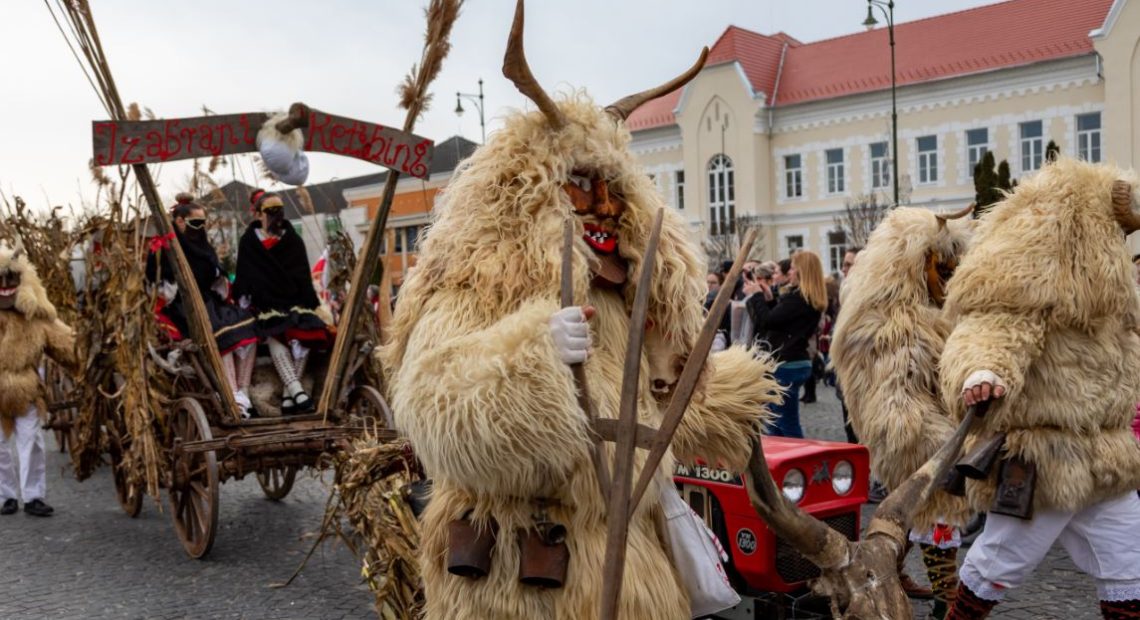Festivals and traditions for saying goodbye to Winter in Hungary

Hungary has a long tradition of warding off winter and waiting for spring, and there are many customs and beliefs associated with these themes. One of the most important and best-known traditions, which also affects international tourism flows in the region, is the Busójárás in Mohács, this year taking place on 8-13 February. Gastronomy delights and festivities also play a big role during carnival season offering plenty of great adventures for tourists visiting all parts of the country.
Busójárás (Busó Walk)
Busójárás is one of the most spectacular, exciting, and unique traditions during the carnival season. It is an internationally known and visited folk festivity that originated from the tradition of the Sokác people of Mohács. The origins of the tradition are locally linked to the expulsion of the Turks, according to which the former inhabitants of the Mohács area hid in the marshland dressed in masks and made noise to drive away the superstitious Turks. Others believe that the custom was brought by the Sokác of Balkan origin when they settled in the area, and it was here that it developed into its present form.
The essence of the Busójárás is ‘poklade‘, which means transformation. It is a time when many things are permitted that everyday life does not allow. In Buso tradition, the face, the identity, must remain hidden during the festivity, and some people even change their masks to do so.
The ‘busó’ is the main character of the feast: a wooden-faced monster in an upturned fur coat and straw-stuffed trousers, perhaps with a knobby stocking. The fur is held together by a chain or rope, sometimes a belt, and a permanent accessory is a cudgel or a wooden mallet. They may also have other accessories such as a wooden fork, a water carrier, bullhorns, a doll in a wooden tub, or a gourd attached to the waist.
One of the most popular activities is the evening bonfire lighting: a huge bonfire the size of a house is lit in the middle of the main square for the busós and guests to dance around, while the loud music is occasionally interrupted by the sound of Turkish cannons.
Interesting facts about Busó Walk:
- Carnival Sunday is the day when the busós cross the Danube when the parade is held, when the coffin of winter is launched, and when the biggest bonfire is built.
- The masks, which have become a symbol of the holiday, are made by professional mask carvers and folk artisans, and their style is recognisable in their work. Some people believe that the real busó carves his own mask.
- The traditional shout of the busós during the parade is “Bao-bao!”.
- The busó horn was made from willow that had been split and hollowed out, tied with twigs in several places to prevent it from falling apart, and then put in the barn, where it swelled well in the humid air and made a beautiful sound. The horn, often three metres long, was carried by one busó and blown by another. Nowadays, more easily handled sound-making devices are generally in use.
- Folk musicians accompany the busó groups on all six days of the carnival. The orchestral accompaniment is usually a tamboura band, but more recently bagpipers also take part in the parade.
The Mohács buso walk generates significant international tourist traffic in Hungary every year, according to the National Tourism Data Supply Center. Last year, Harkány, famous for its thermal baths, and Villány, one of the country’s most important red wine-producing centres, saw the biggest increase in the number of foreign guest nights during this period. Harkány and Villány saw a 1.4-fold increase and a nearly four-fold increase respectively compared to the same period the previous week. In the Pécs-Villány area, the highest numbers of visitors during the Busójárás week were generated by Serbs and Croats, as well as Germans, Slovaks and Romanians.
Date: 2024.02.08-13.
Location: Mohács
More information: 2024, Busójárás
Further folk traditions to chase away winter and celebrate the carnival season
The carnival period in Hungary runs from Epiphany, 6 January to Ash Wednesday which takes place on 14 February this year. During the carnival, people tried to ward off the harsh winter with various customs and spectacular events, let’s have a look what are the most important Hungarian carnival traditions!
According to superstition, burning a ‘kiszebáb’ which is a handmade puppet, will rid people of all ills. The custom of burying winter with this tradition was very popular among the villagers. It consisted of children making the puppet and noisemaking tools, with which they would march to the main square in the village. The procession ended at the bonfire, where the people gathered to pin up the kiszebáb with tags and throw it into the fire. They wrote on the papers what they wanted to get rid of. Until the bonfire burns down, they sing folk songs to welcome spring.
Carnival parties also played a very important role in the choice of a mate. The girls would give a tiny flower to the boy closest to their hearts so that he could appear at the carnival dance with the flower pinned to his hat. If the boy had been courting the girl for a long time, he could not be surprised if his dance partner stole his hat to pin the flower on it – a symbol of her commitment. This public display was often followed by a proposal.
It’s also important to mention the Women’s Carnival on Carnival Monday, a popular dance party for women. On this day, ladies could drink unlimited alcohol, sing songs, and have fun like men. From then until Easter, it was prohibited to dance, make parties, and celebrate weddings.
Festive food specialties
There is no shortage of big feasts during the carnival season. This is the time when rich, meaty soups, goulash, and bean goulash are served. Among the main courses, wine-roasted ‘drunken’ meats such as chicken, duck, roast beef in red wine or veal are typical carnival dishes. Meat jelly which is basically a meat soup in a jelly format, also called the ‘winter hungaricum’, is very popular among Hungarians and definitely worth to taste it while visiting a food market or gourmet festival.
The most classic carnival delicacy is the donut, which takes different forms from one region to another. The carnival donut can be salty or sweet and with or without filling. In Hungary, many superstitions are attached to donuts. In Szerémség for example, people made them to ensure that storms wouldn’t blow the roofs off their houses. The carnival season was also about finding a partner: girls gave doughnuts to the boys they fancied, and the boys endearingly called their lovers “donuts”. If a couple broke a donut in half together, their wedding was almost certainly near because the ribbon running around the side of the donut was a symbol of the wedding ring.
The period rich in delicious dishes ends with Gluttonous Thursday when according to tradition, all fatty foods should be eaten to ensure that no forbidden ingredients are added to food during the lent. Opinions differ as to whether it was originally the Thursday before or after Ash Wednesday. In Hungary, the revived tradition, which is joined by more and more restaurants every year, falls on the Thursday after Ash Wednesday.
Tourists can experience all these carnival adventures across the country in the main squares of big cities such as Budapest, Debrecen, Szeged, Miskolc or Pécs. Musical entertainments make this period even more enjoyable for all generations. Food markets and traditional restaurants await visitors with seasonal delicacies. If you would like to experience something unique, start your journey and taste the carnival atmosphere in Hungary!
Last Updated on 11 months by News Desk 1












